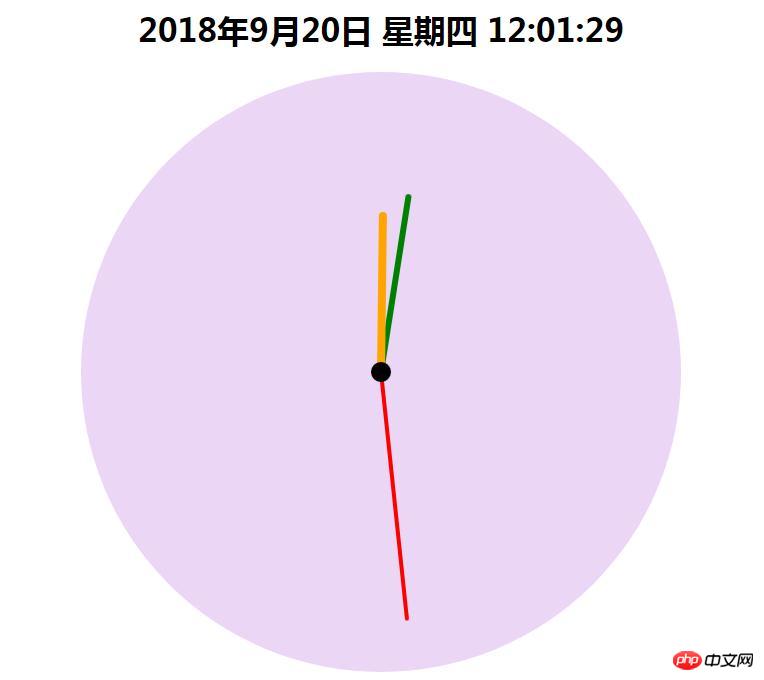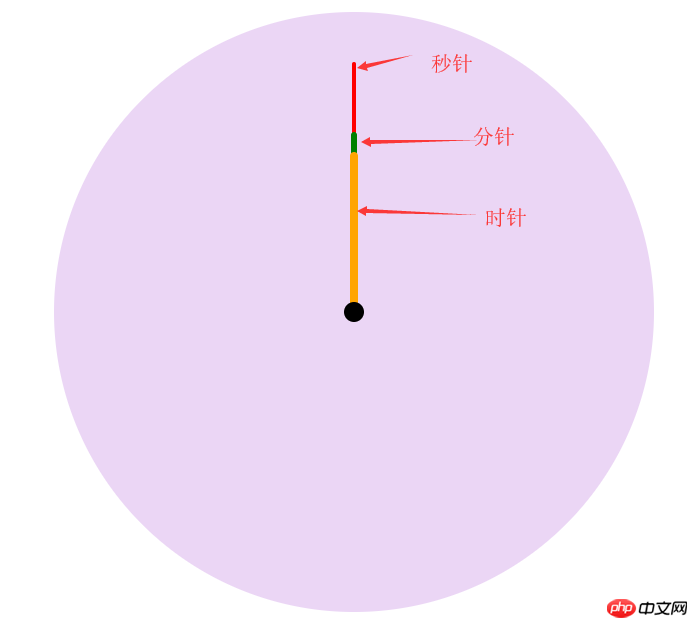
Dieses Kapitel stellt vor, wie man CSS3 und JS verwendet, um dynamische Takteffekte zu erzielen. Ich hoffe, dass es für Sie hilfreich ist.
Werfen wir zunächst einen Blick auf die Renderings:

Zuerst habe ich über das Layout der Seite nachgedacht. Es erfordert ungefähr 4 Schichten von Divs . Die unterste Ebene ist ein Hintergrundbild des Zifferblatts, und die restlichen drei Ebenen sind die Ebenen Stundenzeiger, Minutenzeiger und Sekundenzeiger.
<div class="dial">
</div>
<div class="bigdiv bigdiv1" id="secondHand">
<div class="secondHand"></div>
</div>
<div class="bigdiv bigdiv2" id="minuteHand">
<div class="minuteHand"></div>
</div>
<div class="bigdiv bigdiv3" id="hourHand">
<div class="center"></div>
<div class="hourHand"></div>
</div>Der Variablenname wird zufällig ausgewählt, das Div mit class=center ist der kleine schwarze Punkt in der Mitte der Uhr
Der Stundenzeiger dreht sich einmal in 60*60*60 Sekunden. Der Minutenzeiger dreht sich in 60*60 Sekunden und der Sekundenzeiger dreht sich in 60 Sekunden. Der CSS-Code lautet also wie folgt:
.dial{
width:600px;
height:600px;
margin:0 auto;
position: absolute;
border-radius: 50%;
overflow: hidden;
background-color: rgba(153,50,204,0.2);
background-image: url(img/表盘.jpg);
background-size: 100% 100%;
}
.bigdiv{
width:600px;
height:600px;
margin:0 auto;
position: absolute;
border-radius: 50%;
overflow: hidden;
}
.bigdiv>div{
position: absolute;
left:298px;
border-radius: 100px;
}
.bigdiv1{
animation: moves 60s steps(60) infinite;
}
.bigdiv1 .secondHand{
width:4px;
height:250px;
background-color: red;
top:50px;
left:298px;
}
.bigdiv2{
animation: moves 3600s steps(3600) infinite;
}
.bigdiv2 .minuteHand{
width:6px;
height:180px;
background-color: green;
top:120px;
left:297px;
}
.bigdiv3{
animation: moves 216000s steps(216000) infinite;
}
.bigdiv3 .hourHand{
width:8px;
height:160px;
background-color: orange;
top:140px;
left:296px;
border-radius: 100px;
}
.bigdiv .center{
top:290px;
left:290px;
width:20px;
height:20px;
background-color: black;
z-index: 2;
}
@keyframes moves{
from{ transform: rotateZ(0deg); }
to{ transform: rotateZ(360deg); }
}Nach Abschluss dieses Schritts sieht das Rendering folgendermaßen aus:
 Dann verwenden Sie js, um die aktuelle Zeit zu berechnen,
Dann verwenden Sie js, um die aktuelle Zeit zu berechnen,
var date = new Date(); var hours = date.getHours(); var minutes = date.getMinutes(); var seconds = date.getSeconds();
und dann die aktuelle Zeit jedes Nadeldrehwinkels zu berechnen
var secondAngle = seconds; var minuteAngle = minutes * 60 + seconds; var hourAngle = (60/12) * ((hours%12) * 3600 + minuteAngle);
Die aktuelle Idee ist: jede Nadel dreht sich einmal entsprechend seiner eigenen Zeit, und der Anfangswinkel kann auch bekannt sein. Wie erstelle ich eine dynamische Uhr, die die aktuelle Zeit anzeigt?
Die ursprüngliche Idee bestand darin, diese drei Schichten von Divs entsprechend zu drehen Dann konnte ich aber nicht daran denken, weil es sich immer noch einmal zu einem festen Zeitpunkt dreht und die Zeigerrichtung abweicht.
Was jetzt benötigt wird, ist die Seite Der erste Kreis Das eingehende Zeichen wird in einem festen Winkel gedreht, und der Rest wird in der ursprünglichen festen Zeit gedreht.
Es gibt ein Animationsverzögerungsattribut in CSS3, das eine Animationsverzögerung bedeutet, und eine negative Zahl bedeutet, dass es früher beginnt (Zum Beispiel bedeutet -5s, dass die Animation ab der 5s-Zeit beginnt).
kann gerade rechtzeitig verwendet werden, damit diese Zeiger die entsprechenden Winkel im Voraus starten können.
Der js-Code ist wie folgt:
hourHand.style.cssText = "animation-delay: -"+ hourAngle +"s"; minuteHand.style.cssText = "animation-delay: -"+ minuteAngle +"s"; secondHand.style.cssText = "animation-delay: -"+ secondAngle +"s";
Zuletzt habe ich eine dynamische Zeit zur Anzeige auf der Uhr hinzugefügt
Vollständiger Code:
<!DOCTYPE html>
<html>
<head>
<meta charset="UTF-8">
<title></title>
<style>
body,
html {
margin: 0;
}
.location {
position: relative;
width: 600px;
height: 600px;
left: calc(50% - 300px);
}
.dial {
width: 600px;
height: 600px;
margin: 0 auto;
position: absolute;
border-radius: 50%;
overflow: hidden;
background-color: rgba(153, 50, 204, 0.2);
background-image: url(img/表盘.jpg);
background-size: 100% 100%;
}
.bigdiv {
width: 600px;
height: 600px;
margin: 0 auto;
position: absolute;
border-radius: 50%;
overflow: hidden;
}
.bigdiv>div {
position: absolute;
left: 298px;
border-radius: 100px;
}
.bigdiv1 {
animation: moves 60s steps(60) infinite;
}
.bigdiv1 .secondHand {
width: 4px;
height: 250px;
background-color: red;
top: 50px;
left: 298px;
}
.bigdiv2 {
animation: moves 3600s steps(3600) infinite;
}
.bigdiv2 .minuteHand {
width: 6px;
height: 180px;
background-color: green;
top: 120px;
left: 297px;
}
.bigdiv3 {
animation: moves 216000s steps(216000) infinite;
}
.bigdiv3 .hourHand {
width: 8px;
height: 160px;
background-color: orange;
top: 140px;
left: 296px;
border-radius: 100px;
}
.bigdiv .center {
top: 290px;
left: 290px;
width: 20px;
height: 20px;
background-color: black;
z-index: 2;
}
@keyframes moves {
from {
transform: rotateZ(0deg);
}
to {
transform: rotateZ(360deg);
}
}
#dateshow {
text-align: center;
}
</style>
</head>
<body>
<h1 id="dateshow"></h1>
<div class="location">
<div class="dial"></div>
<div class="bigdiv bigdiv1" id="secondHand">
<div class="secondHand"></div>
</div>
<div class="bigdiv bigdiv2" id="minuteHand">
<div class="minuteHand"></div>
</div>
<div class="bigdiv bigdiv3" id="hourHand">
<div class="center"></div>
<div class="hourHand"></div>
</div>
</div>
<script>
var dateshow = document.getElementById("dateshow");
var clock = {
weeks: ["一", "二", "三", "四", "五", "六", "日"],
getDate: function() {
date = new Date();
year = date.getFullYear();
month = date.getMonth() + 1;
day = date.getDate();
hours = date.getHours();
minutes = date.getMinutes();
seconds = date.getSeconds();
week = date.getDay(); // 星期
dateText = year + "年" + month + "月" + clock.format(day) + "日 星期" + clock.formatnum(week) + " " +
clock.format(hours) + ":" + clock.format(minutes) + ":" + clock.format(seconds);
return dateText;
},
format: function(data) {
if(data.toString().length == 1) {
data = "0" + data;
};
return data;
},
formatnum: function(num) {
return clock.weeks[num - 1];
},
showdate: function() {
dateshow.innerText = clock.getDate();
},
go: function() {
var secondHand = document.getElementById("secondHand");
var minuteHand = document.getElementById("minuteHand");
var hourHand = document.getElementById("hourHand");
date = new Date();
hours = date.getHours();
minutes = date.getMinutes();
seconds = date.getSeconds();
var secondAngle = seconds;
var minuteAngle = minutes * 60 + seconds;
var hourAngle = (60 / 12) * ((hours % 12) * 3600 + minuteAngle);
hourHand.style.cssText = "animation-delay: -" + hourAngle + "s";
minuteHand.style.cssText = "animation-delay: -" + minuteAngle + "s";
secondHand.style.cssText = "animation-delay: -" + secondAngle + "s";
}
}
clock.go();
clock.showdate();
setInterval("clock.showdate()", 1000);
</script>
</body>
</html>Das obige ist der detaillierte Inhalt vonCSS3+JS zeichnet dynamische Uhr (mit Code). Für weitere Informationen folgen Sie bitte anderen verwandten Artikeln auf der PHP chinesischen Website!